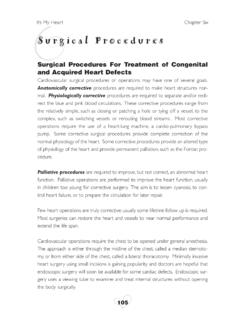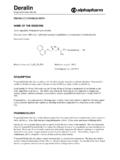Transcription of Coronary CT Angiography (CTA) and Calcium Scoring # …
1 1 Coronary CT Angiography (CTA) and Calcium Scoring # 01058 CPT Codes 0145T 0151T Experimental Code 0144T, S8092 Coronary CT Angiography (CTA) is a noninvasive imaging study that uses contrast material and high-resolution, rapid imaging CT equipment to obtain detailed images of blood vessels. CTA can image blood vessels throughout the body. It has been used as an alternative to conventional invasive Coronary Angiography for evaluating Coronary artery disease and Coronary artery anomalies. The performance of CTA has improved by increasing the number of slices that can be acquired simultaneously.
2 As the number of slices increases, the scanning time is shortened and the resolution is increased. Initial cardiac CT imaging was conducted with 4-slice then with 16-slice and now uses 64-slice detector CT. When used herein the Assessment Tools for estimating risk of developing myocardial infarction and Coronary death is either from: 1) Framingham Heart Study data to assess adults age 20 years and older who do not have heart disease or diabetes. The factors used are age; gender; total cholesterol; HDL cholesterol; smoking; systolic blood pressure; and whether patient is currently on any medication for high blood pressure.
3 Use the following link or, 2) the following table: Age(yrs) Gender Typical / Definite Angina Pectoris Atypical / Probable Angina Pectoris Non-anginal Chest Pain Asymptomatic 30-39 Men Intermediate Intermediate Low Very Low Women Intermediate Very Low Very Low Very Low 40-49 Men High Intermediate Intermediate Low Women Intermediate Low Very Low Very Low 50-59 Men High Intermediate Intermediate Low Women Intermediate Intermediate Low Very Low 60-69 Men High Intermediate Intermediate Low Women High Intermediate Intermediate Low High: greater than 90% pretest probability; Intermediate: between 10% and 90% pretest probability; Low: between 5% and 10% pretest probability; Very low: less than 5% pretest probability.
4 What is it? 2 CTA using 64 slices or greater is considered medically necessary for any the following indications: 1) To rule out significant Coronary stenosis in persons with a low or very low pre-test probability of Coronary Artery Disease (CAD) according to Assessment Tools stated above, with any of the following indications: a) Evaluation of persons with chest pain who cannot perform or have contraindications to exercise and pharmacologic stress testing according to the following: Contraindications to exercise stress testing: Acute myocardial infarction (within 2 days) Unstable angina not previously stabilized by medical therapy Uncontrolled cardiac arrhythmias causing symptoms or hemodynamic compromise Symptomatic severe aortic stenosis Uncontrolled symptomatic heart failure Acute pulmonary embolus or pulmonary infarction Acute myocarditis or pericarditis Acute aortic dissection.
5 Exercise stress testing is not useful in persons who are unable to exercise, persons on Digoxin, persons who have a cardiac conduction abnormality that prevents achievement of an adequate heart rate response, persons on a medication ( , beta blockers, other negative chronotropic agents) that cannot be stopped which prevent achievement of an adequate heart rate response, and persons with an uninterpretable electrocardiogram (a ventricular paced rhythm, complete left bundle branch block, ventricular pre-excitation arrhythmia (Wolfe Parkinson White syndrome), or greater than 1 mm ST segment depression at rest).
6 Contraindications to Adenosine or Dipyridamole (Persantine) stress testing: Active bronchospasm or reactive airway disease; Sick sinus syndrome or greater than first-degree heart block (in persons without a ventricular-demand pacemaker); Systolic blood pressure (SBP) less than 90 mm Hg; Severe bradycardia (heart rate less than 40 beats per minute); Patients using methylxanthines (such as caffeine and aminophylline) (In general, patients should refrain from ingesting caffeine for at least 24 hours prior to adenosine or dipyridamole administration); Patients taking Persantine (contraindicated for adenosine testing).
7 Contraindications to Dobutamine stress testing: Within 7 days of myocardial infarction; Criteria 3 Unstable angina; Significant aortic stenosis or obstructive cardiomyopathy; Atrial tachyarrhythmia with uncontrolled ventricular response; History of ventricular tachycardia, Uncontrolled hypertension, Thoracic aortic aneurysm; Left bundle branch block. or, b) Evaluation of persons with a positive ( , greater than or equal to 1 mm ST segment depression) exercise stress test; or, c) Evaluation of persons with chest pain presenting to the emergency department when an imaging stress test or Coronary Angiography is being deferred as the initial imaging study.
8 Or, 2) To evaluate an individual with a low or very low pretest probability of CAD when recent stress test results (exercise treadmill, stress echo, or nuclear stress test) are uninterpretable, equivocal, or there is a suspicion that the results are falsely positive and CTA will be performed in lieu of an Angiography Note: current guidelines recommend against routine stress testing for screening asymptomatic adults.; or, 3) Preoperative assessment of persons scheduled for high risk surgery, when an imaging stress test or invasive Coronary Angiography is being delayed unless absolutely necessary.
9 High risk surgery means: an emergent operation, especially in the elderly; aortic and other major vascular surgeries; peripheral vascular surgeries; and, anticipated prolonged surgical procedures with large fluid shifts and/or blood loss involving the abdomen and thorax; or, 4) Preoperative assessment for planned non- Coronary cardiac surgeries including valvular heart disease, congenital heart disease and pericardial disease in lieu of cardiac catheterization as the initial study; or, 5) Evaluation of pulmonary veins in persons undergoing pulmonary vein isolation procedures for atrial fibrillation (pre and post ablation procedure); or, 6) Evaluation of person with new onset of heart failure to assess etiology when ischemia is suspected and cardiac catheterization and/or nuclear stress test has not been performed; or, 7) Evaluation of persons requiring biventricular pacemakers to accurately identify the Coronary veins for lead placement; or, 8) Evaluation of cardiac structure and morphology for the following indications: a) Marfan s syndrome.
10 B) Evaluation of atrial-septal defect; c) Kawasaki s disease; 4d) Anomalous pulmonary venous drainage; e) Pulmonary outflow tract obstruction; f) Surgical repair of tetralogy of Fallot or other congenital heart disease; g) Evaluation of other complex congenital heart diseases, anomalies or masses (such as cardiac tumor, pericardial mass or constrictive pericarditis). CTA is considered experimental and investigational for all other clinical applications, including but not limited to: 1) screening of asymptomatic persons; or, 2) evaluation of persons at intermediate or high pretest probability of CAD; or, 3) evaluation of stent occlusion or in-stent restenosis; or, 4) evaluation after revascularization procedures (such as percutaneous Coronary intervention, Coronary artery bypass grafting).








